9 Ways Clickstream Analytics Transforms Market Research Insights

9 Ways Clickstream Analytics Transforms Market Research Insights
Overview
Clickstream analytics serves as a transformative tool in market research by delivering detailed user behavior data. This feature allows businesses to gain a deeper understanding of consumer preferences, identify emerging market trends, and refine their marketing strategies. By leveraging this data, companies can enhance customer experiences and improve conversion rates.
How can your organization benefit from these insights? Ultimately, incorporating clickstream analytics leads to informed, data-driven decisions that drive organizational success.
Introduction
In an era where data drives decision-making, clickstream analytics emerges as a transformative tool for market research, offering unprecedented insights into consumer behavior. By harnessing diverse datasets and real-time user interactions, organizations can uncover patterns that inform marketing strategies and enhance customer experiences. Yet, the challenge remains: how can businesses effectively leverage this wealth of information to stay ahead in an increasingly competitive landscape? This article explores nine pivotal ways clickstream analytics reshapes market research insights, empowering companies to make informed, data-driven decisions that resonate with their target audiences.
Initial Data Offering: Access Diverse Datasets for Enhanced Market Insights
The Initial Data Offering (IDO) serves as a pivotal resource for accessing a variety of datasets, including alternative information, fundamental data, and ESG information. This diverse assortment of datasets offers market researchers the ability to gain comprehensive insights into consumer behavior, market trends, and competitive landscapes. As we approach 2025, the significance of alternative data in shaping market insights is becoming increasingly recognized. Organizations are leveraging these resources to enhance their strategic decisions.
The importance of diverse datasets in market research is profound; they provide the nuanced understanding essential for effective analysis and informed decision-making. Industry specialists emphasize that accessing high-quality datasets is crucial for uncovering consumer insights that drive organizational success. IDO's dedication to curating and facilitating access to these datasets ensures that market researchers possess the necessary tools to navigate the complexities of today's data-driven environment.
How can you leverage these datasets to gain a competitive edge? The answer lies in understanding their potential to inform your strategic choices.
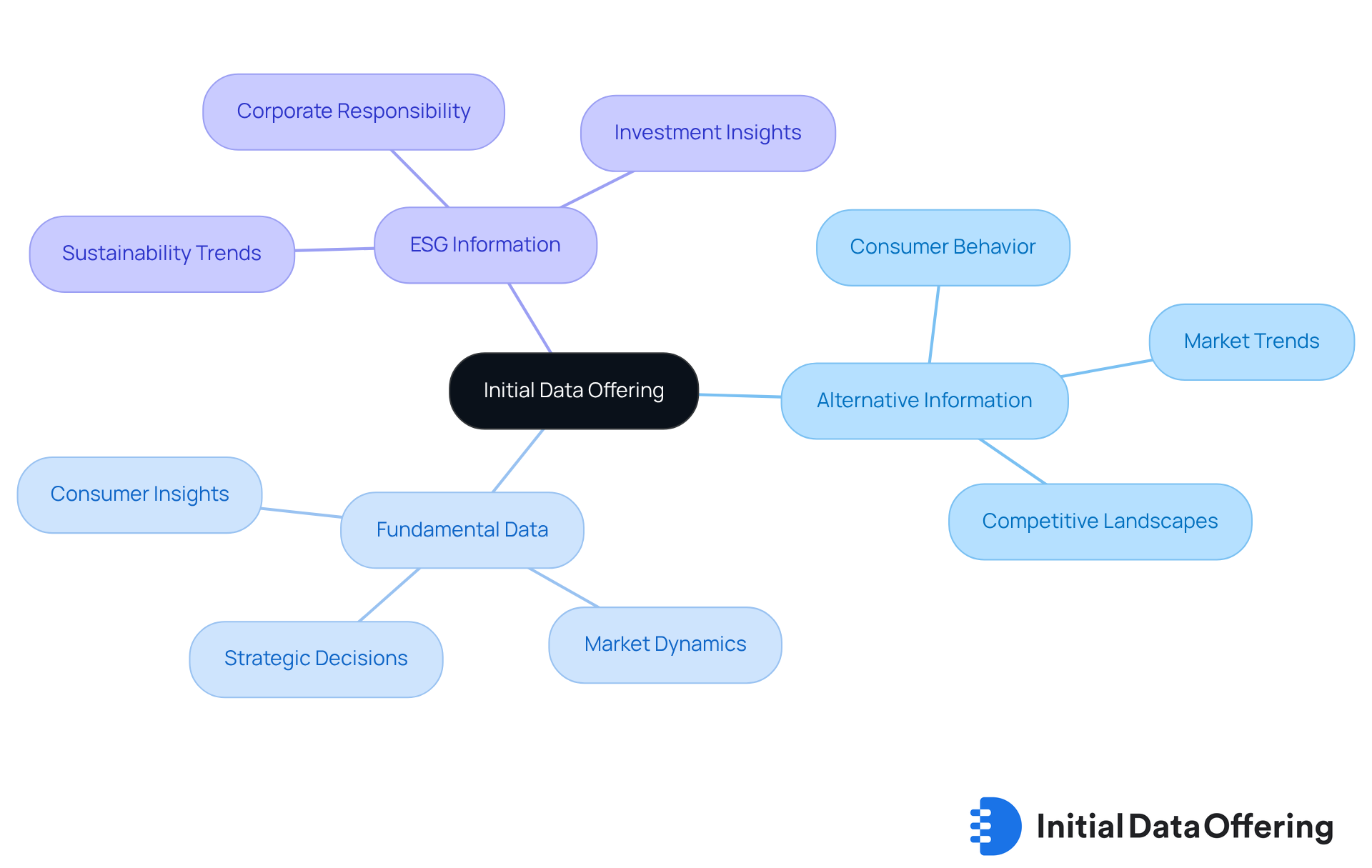
User Behavior Tracking: Understand Consumer Preferences Through Clickstream Analytics
A comprehensive perspective on user interactions on websites is provided by clickstream analytics. This feature enables companies to use clickstream analytics to monitor how consumers navigate through digital platforms. The advantage of examining this information lies in the ability to identify consumer preferences, interests, and pain points. By understanding these elements, companies can customize their products and marketing strategies effectively. Ultimately, this approach benefits organizations by aligning their offerings with consumer needs, fostering a more tailored and engaging user experience.
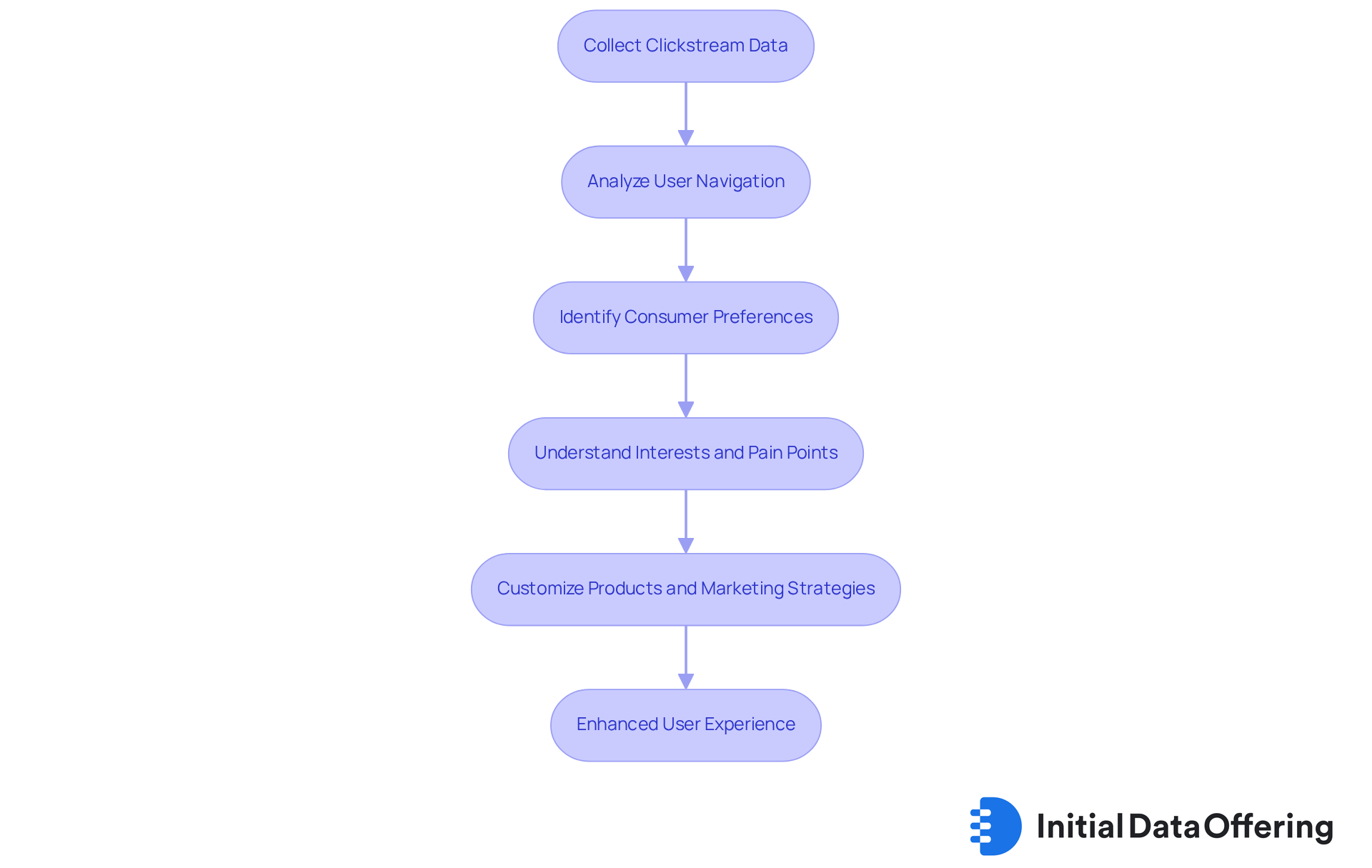
Trend Identification: Leverage Clickstream Data to Spot Market Trends
By examining user activity data, companies can effectively identify emerging trends in consumer behavior and preferences. This data-driven approach not only enables organizations to stay ahead of the curve but also allows them to adapt their offerings and marketing strategies to align with evolving market demands.
For instance, the notable increase in searches for sustainable products—projected to grow significantly as the application of clickstream analytics in E-commerce is expected to reach 2.6 billion USD by 2032—can prompt businesses to enhance their eco-friendly offerings.
As emphasized by HubSpot, "By utilizing user behavior insights within its platform, HubSpot enables marketers to make informed decisions that enhance targeting and improve overall marketing strategies."
In 2025, companies utilizing web traffic analysis are anticipated to enhance their product offerings considerably, reacting to real-time consumer insights. Furthermore, new patterns in consumer behavior, such as the rising need for tailored experiences and sustainability, are propelling the development of web activity analytics, rendering it an essential resource for market research.
To effectively utilize these insights, market research analysts should regularly monitor clickstream analytics to identify shifts in consumer preferences and adjust strategies accordingly.
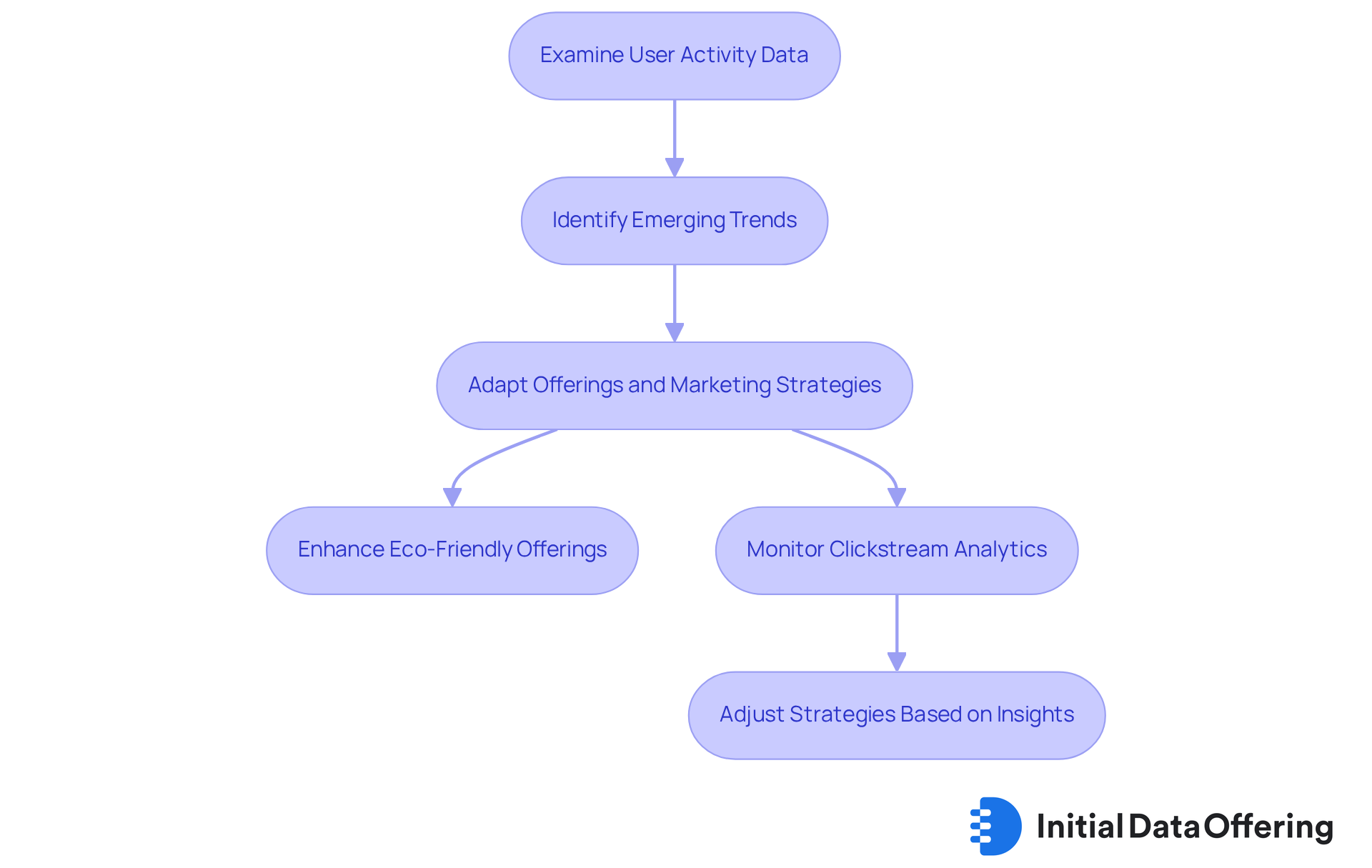
Conversion Funnel Optimization: Improve Sales Strategies with Clickstream Insights
Clickstream analytics is an essential tool for companies seeking to understand where individuals drop off in the conversion funnel. By identifying these bottlenecks, businesses can utilize clickstream analytics to implement targeted strategies that enhance customer experience and ultimately increase conversion rates.
For instance, if data reveals that individuals frequently leave their carts at a specific stage, companies can simplify that step. This improvement not only streamlines the buying process but also contributes to a more satisfactory overall experience for customers.
How can your organization leverage these insights to refine its strategies?
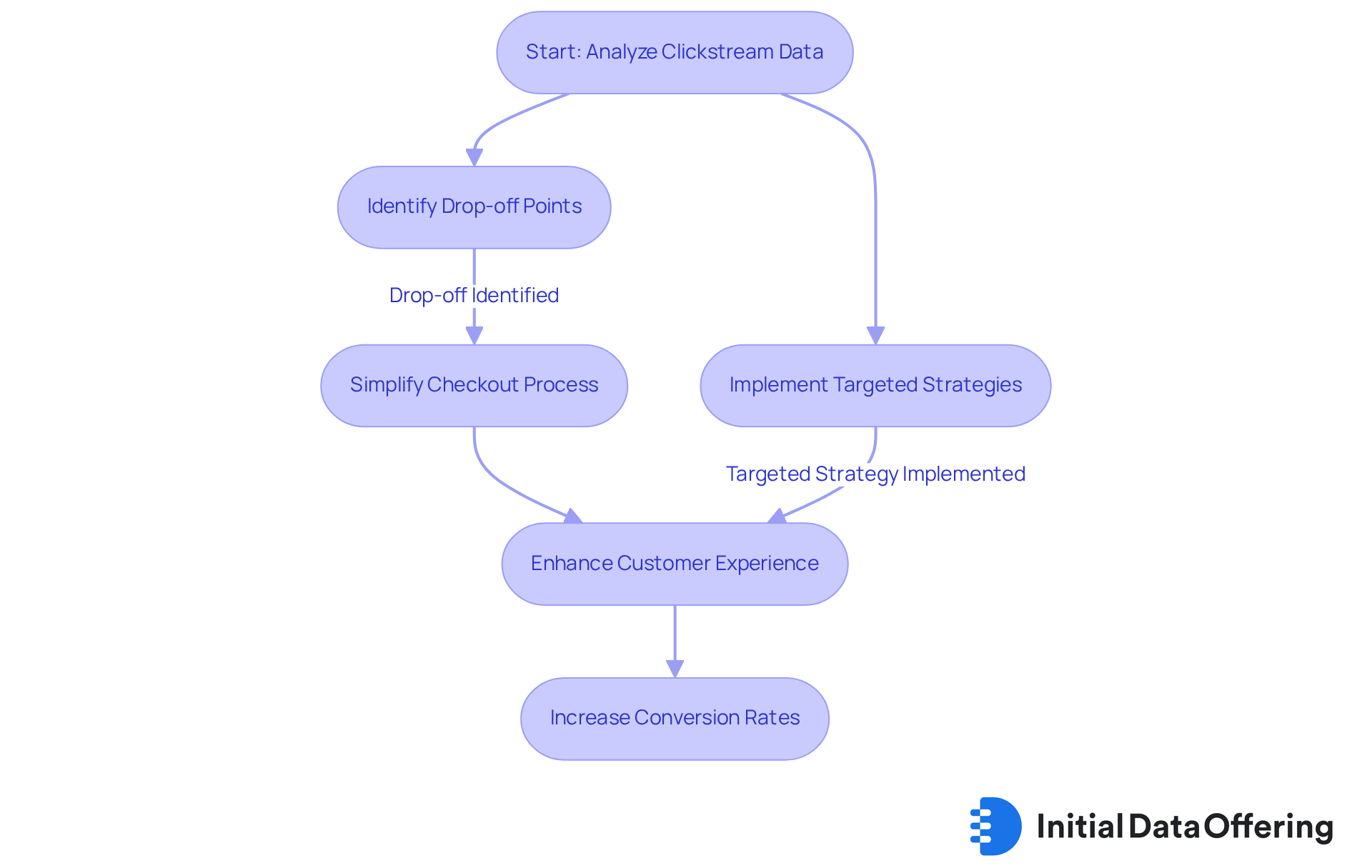
Competitor Analysis: Gain Insights from Competitor Clickstream Data
Examining competitor traffic data is essential for companies seeking to enhance their market strategies. By understanding how rivals attract and retain customers, organizations can uncover valuable insights into user engagement tactics and identify gaps in their own approaches. This understanding enables businesses to capitalize on opportunities for differentiation in a competitive landscape.
For instance, the click path optimization segment, which commands the largest market share, is anticipated to expand at a CAGR of 13.5%. Meanwhile, the total market for click data analytics is forecasted to grow at a CAGR of 13.9% during the prediction period from 2025 to 2033. As noted by an Associate Partner at LINX Market Intelligence, "the essence of competitive intelligence lies in converting gathered information into actionable insights." This allows businesses to make informed decisions that enhance customer retention and improve overall performance.
In 2025, companies utilizing clickstream analytics from competitors will likely focus on optimizing their marketing strategies and improving client experiences. Ultimately, this will drive better outcomes in a rapidly evolving market. How can your organization leverage these insights to stay ahead of the competition?

Bounce Rate Reduction: Enhance User Retention with Clickstream Analytics
Elevated bounce rates frequently indicate that visitors are not discovering what they anticipate on a website. Clickstream analytics acts as a vital tool, allowing businesses to identify particular pages or elements that result in visitor drop-off. This advantage allows organizations to examine interactions closely, applying focused enhancements such as optimizing page load durations and improving content relevance.
For instance, companies that have effectively utilized clickstream analytics have reported significant reductions in bounce rates. Some studies indicate a decrease of up to 30% in bounce rates after implementing data-driven changes. The benefit of this data-driven method extends beyond mere statistics; it enhances the overall experience for individuals and cultivates long-term customer loyalty. Individuals are more likely to engage with content that aligns with their expectations.
According to digital marketing specialists, comprehending visitor behavior through metrics such as time spent on pages and visitor pathways is essential for enhancing retention strategies.
How can your organization leverage these insights to improve visitor engagement?
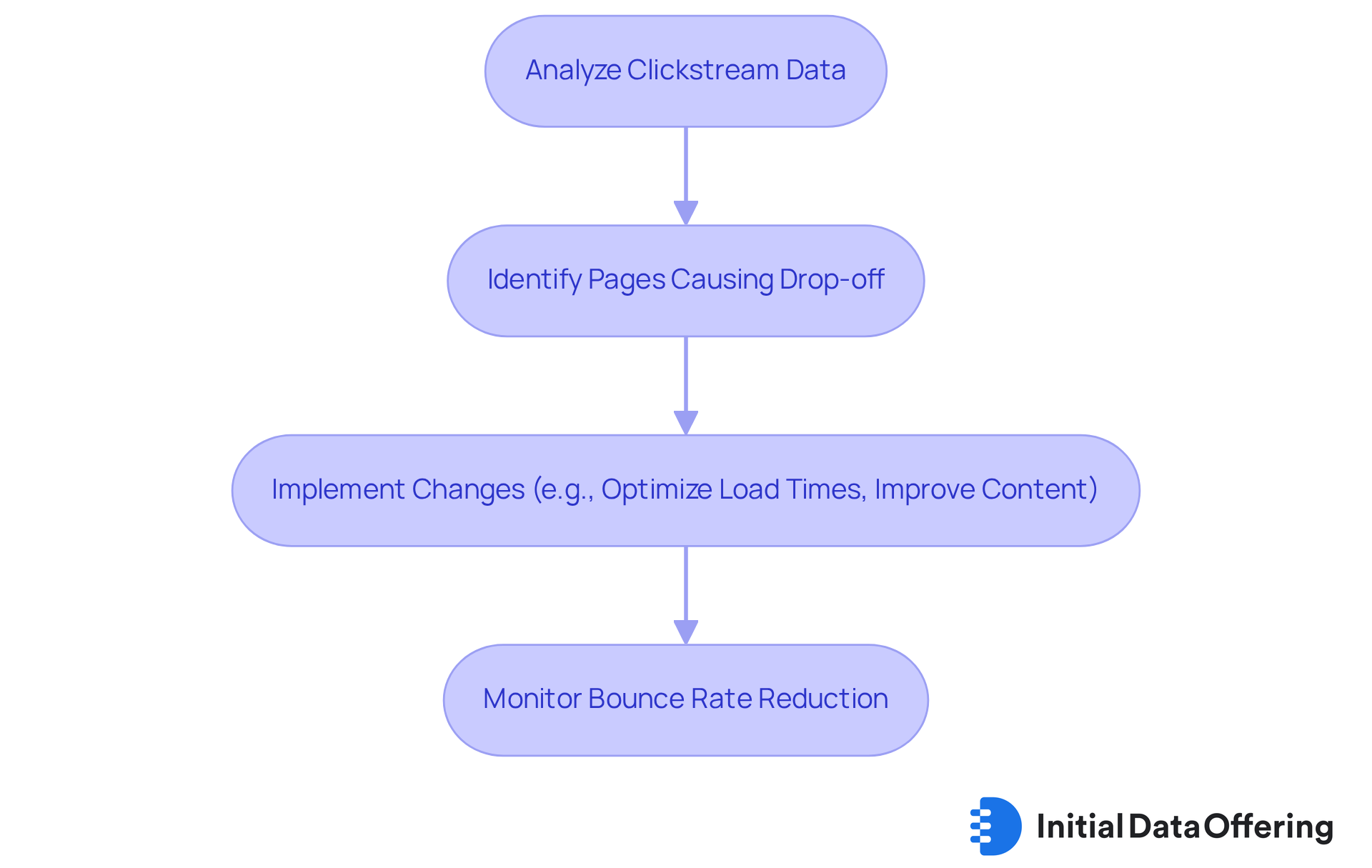
Personalization Strategies: Enhance Engagement Through Clickstream Data
Clickstream analytics provides companies with a profound understanding of individual preferences and behaviors, which is essential for creating customized experiences. By tailoring content, recommendations, and marketing messages to align with specific interests, companies can significantly enhance engagement and foster customer loyalty. For example, online shopping sites utilize browsing data to recommend products based on individuals' past activities, thereby increasing the chances of conversion. The personalization of these experiences not only boosts the likelihood of repeat purchases but is also crucial for driving revenue and maximizing customer lifetime value.
As we approach 2025, personalization is expected to become a standard expectation among consumers. Companies that effectively leverage web traffic analysis will not only enhance customer satisfaction but also encourage repeat purchases. Marketing professionals emphasize that tailored experiences are vital for fostering deeper connections with customers, making it essential for brands to prioritize personalization strategies in their engagement efforts. Additionally, implementing A/B testing can refine these strategies, ensuring that content resonates with individuals while balancing personalization with privacy to avoid intrusive marketing practices.
Instruments such as Google Analytics and Adobe Analytics are indispensable for examining user interactions. These tools allow companies to enhance their personalization initiatives, ultimately leading to more effective engagement with their audience. How can your organization utilize clickstream analytics to improve customer experiences? By understanding these dynamics, businesses can better position themselves to meet the evolving expectations of their customers.
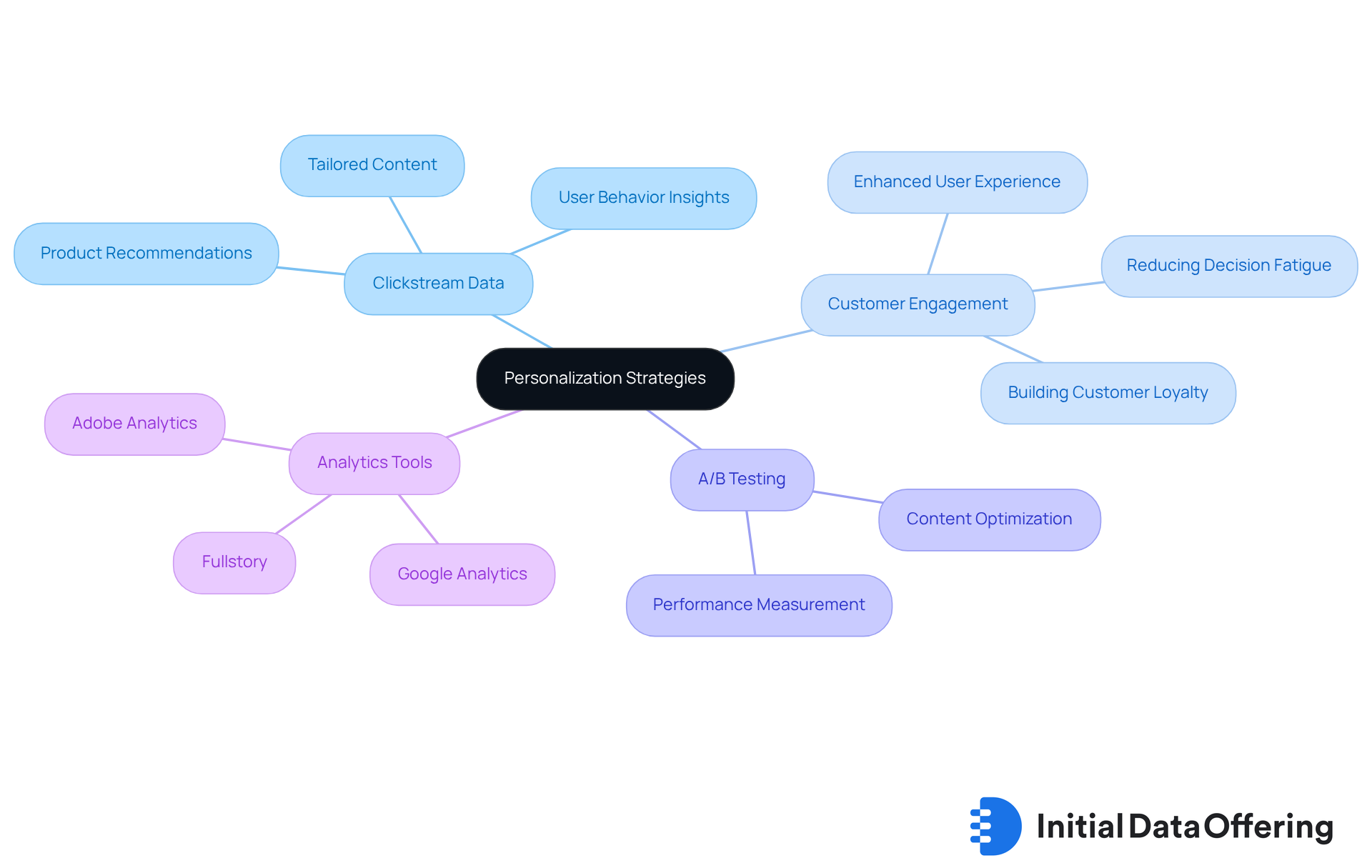
Timely Insights: Respond to Market Changes with Real-Time Clickstream Data
Clickstream analytics provides companies with real-time user activity information, enabling a prompt understanding of consumer behavior and market trends. This feature enables businesses to leverage clickstream analytics to respond swiftly to changes, such as shifts in consumer preferences or emerging market opportunities.
For example, when a new trend is identified through clickstream analytics, companies can quickly adjust their marketing strategies to capitalize on it. Moreover, integrating insights from comprehensive datasets, such as Hazeltree's Long and Short Equity Positioning Insights, enhances these strategies by offering a deeper understanding of equity crowding and fund positions. This ultimately informs more nuanced market analyses, allowing companies to make better-informed decisions.
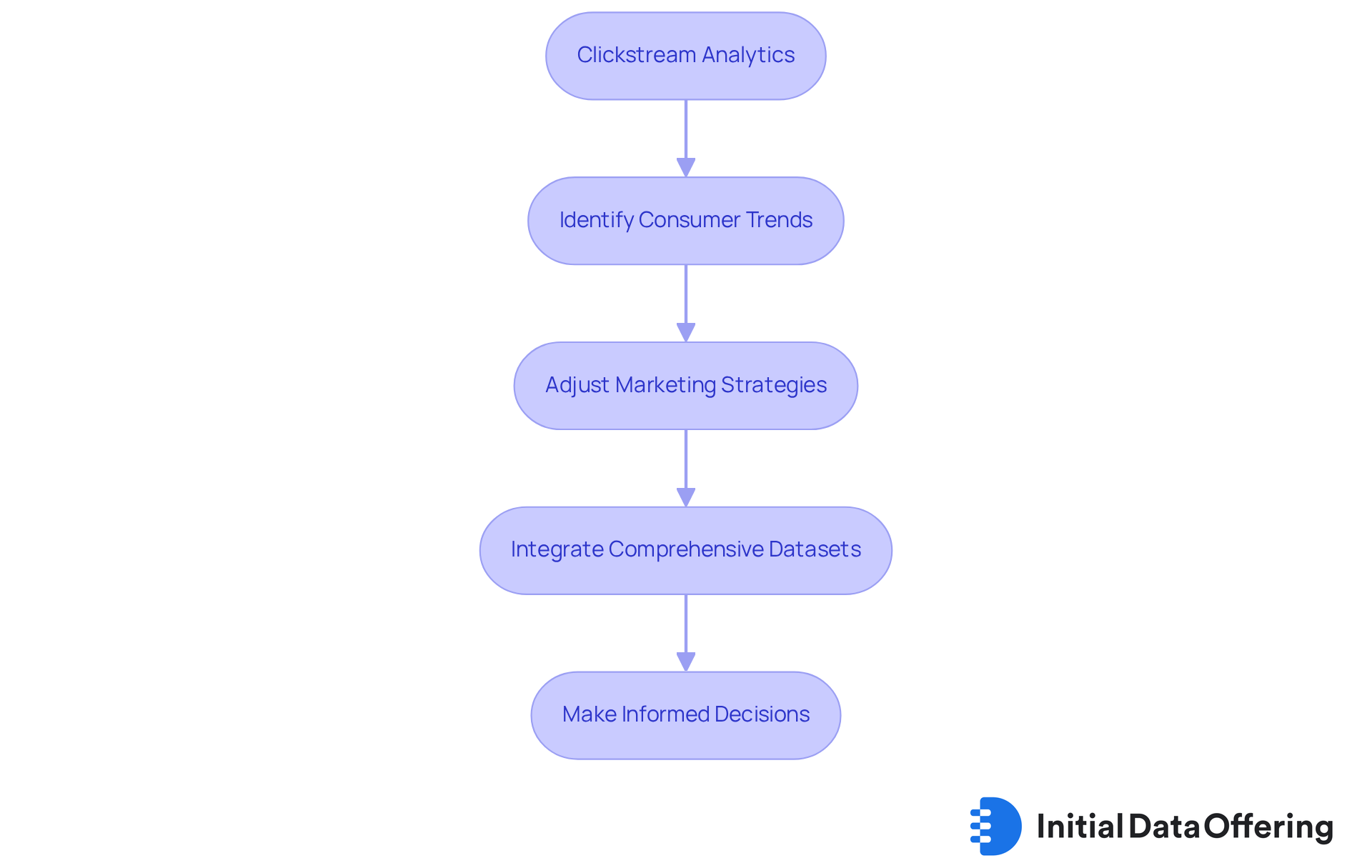
Holistic Customer Journeys: Analyze Comprehensive Clickstream Data
Examining extensive clickstream analytics enables companies to outline the complete customer journey, from initial engagement to final conversion. This holistic perspective is crucial for identifying key touchpoints and interactions that significantly influence user behavior, especially through clickstream analytics. Companies employing journey mapping, for instance, report a 56% increase in cross-sell revenue, particularly among e-commerce firms. This underscores the financial advantages of understanding customer pathways.
As highlighted by Forrester Research, 'we’ve entered the 'Age of the Customer,' where the most successful enterprises are those that systematically comprehend and fulfill customer needs better than their rivals.' By leveraging insights from customer interactions, organizations can refine their marketing strategies and improve experiences, ultimately driving higher conversion rates.
In 2025, companies that effectively comprehend and enhance their customer journeys are anticipated to observe significant advancements in conversion metrics. This reinforces the necessity of a data-driven strategy for customer experience management. To capitalize on these insights, companies should consider implementing journey mapping initiatives that better align their strategies with customer expectations.
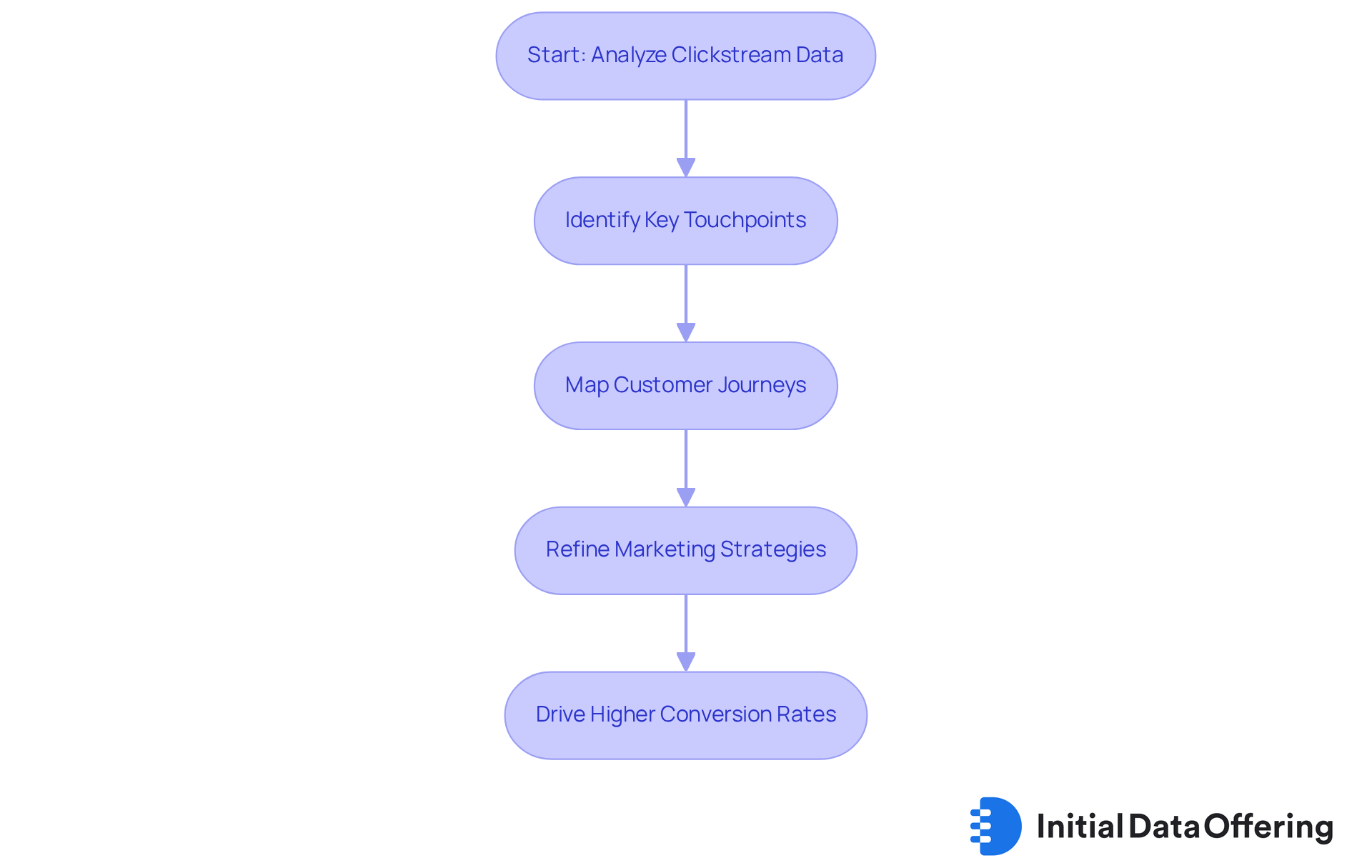
Data-Driven Decisions: Empower Market Research with Clickstream Analytics
Businesses aiming to make informed, data-driven decisions find that clickstream analytics serves as a vital tool. It offers actionable insights into user behavior and market dynamics, which can significantly enhance organizational performance. By utilizing this information, companies can improve their strategies and optimize marketing efforts, leading to better overall performance. For instance, organizations can examine web traffic data to identify which marketing channels produce the highest engagement and conversion rates. This enables more effective resource allocation, streamlining marketing initiatives and empowering market research by providing a clearer understanding of consumer preferences and behaviors.
Industry specialists emphasize the importance of web traffic analysis in enhancing organizational performance. As organizations increasingly adopt data-driven strategies, the ability to analyze user interactions in real-time becomes crucial. Looking ahead to 2025, the influence of user behavior analysis on marketing performance is anticipated to be significant. Companies will utilize these insights to develop hyper-personalized marketing campaigns that connect with target audiences more effectively.
Moreover, actionable insights obtained from user behavior patterns empower market researchers to recognize emerging trends and consumer needs. This facilitates timely modifications in strategy. Companies such as Amazon and Netflix illustrate the effective use of web traffic analytics. They employ user behavior data to guide product suggestions and content distribution, ultimately improving customer satisfaction and loyalty. By integrating clickstream analytics into their decision-making processes, businesses can not only enhance marketing effectiveness but also foster a culture of continuous improvement and innovation.
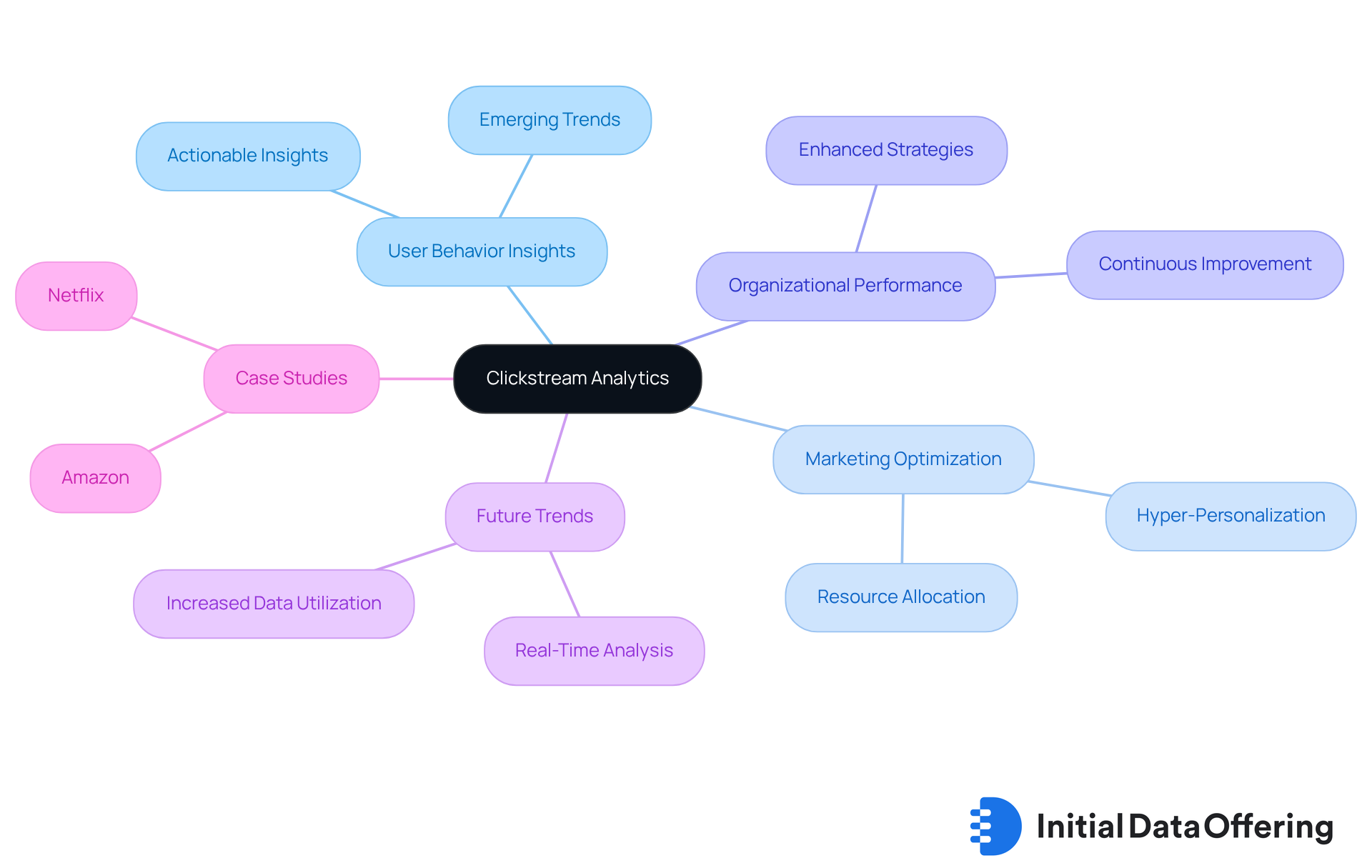
Conclusion
Clickstream analytics is transforming market research by delivering essential insights into consumer behavior and market dynamics. This innovative approach harnesses diverse datasets and real-time user activity data, enabling organizations to make informed decisions that enhance strategic initiatives and drive success in an increasingly competitive landscape.
Throughout this discussion, we have explored various facets of clickstream analytics, including its capability to:
- Track user behavior
- Identify market trends
- Optimize conversion funnels
- Analyze competitor strategies
These insights not only deepen our understanding of consumer preferences but also empower personalized marketing efforts and timely adaptations to market fluctuations. The focus on data-driven decision-making underscores the pivotal role that clickstream analytics plays in equipping market researchers to navigate the complexities of today's digital environment.
As businesses approach 2025, integrating clickstream analytics into market research strategies will be crucial for sustaining a competitive advantage. Organizations are encouraged to leverage these insights to enhance customer engagement, reduce bounce rates, and optimize marketing initiatives. By embracing a data-driven approach, businesses can improve performance and foster a culture of continuous improvement, ultimately leading to stronger connections with consumers and greater market success.
Frequently Asked Questions
What is an Initial Data Offering (IDO)?
An Initial Data Offering (IDO) is a resource that provides access to a variety of datasets, including alternative information, fundamental data, and ESG information, enabling market researchers to gain insights into consumer behavior, market trends, and competitive landscapes.
Why is alternative data important for market insights?
The significance of alternative data is increasingly recognized as it helps organizations enhance their strategic decisions by providing comprehensive insights into consumer behavior and market trends.
How do diverse datasets contribute to market research?
Diverse datasets offer a nuanced understanding essential for effective analysis and informed decision-making, which helps uncover consumer insights that drive organizational success.
What role does clickstream analytics play in understanding consumer preferences?
Clickstream analytics allows companies to monitor how consumers navigate digital platforms, helping them identify consumer preferences, interests, and pain points to customize products and marketing strategies.
How can companies use clickstream data to identify market trends?
By examining user activity data, companies can spot emerging trends in consumer behavior and preferences, enabling them to adapt their offerings and marketing strategies to align with evolving market demands.
What is the projected growth of clickstream analytics in E-commerce by 2032?
The application of clickstream analytics in E-commerce is expected to reach 2.6 billion USD by 2032.
How should market research analysts utilize clickstream analytics?
Market research analysts should regularly monitor clickstream analytics to identify shifts in consumer preferences and adjust their strategies accordingly to stay aligned with market demands.